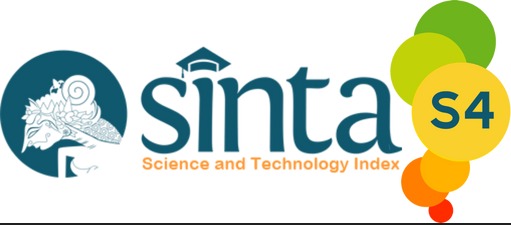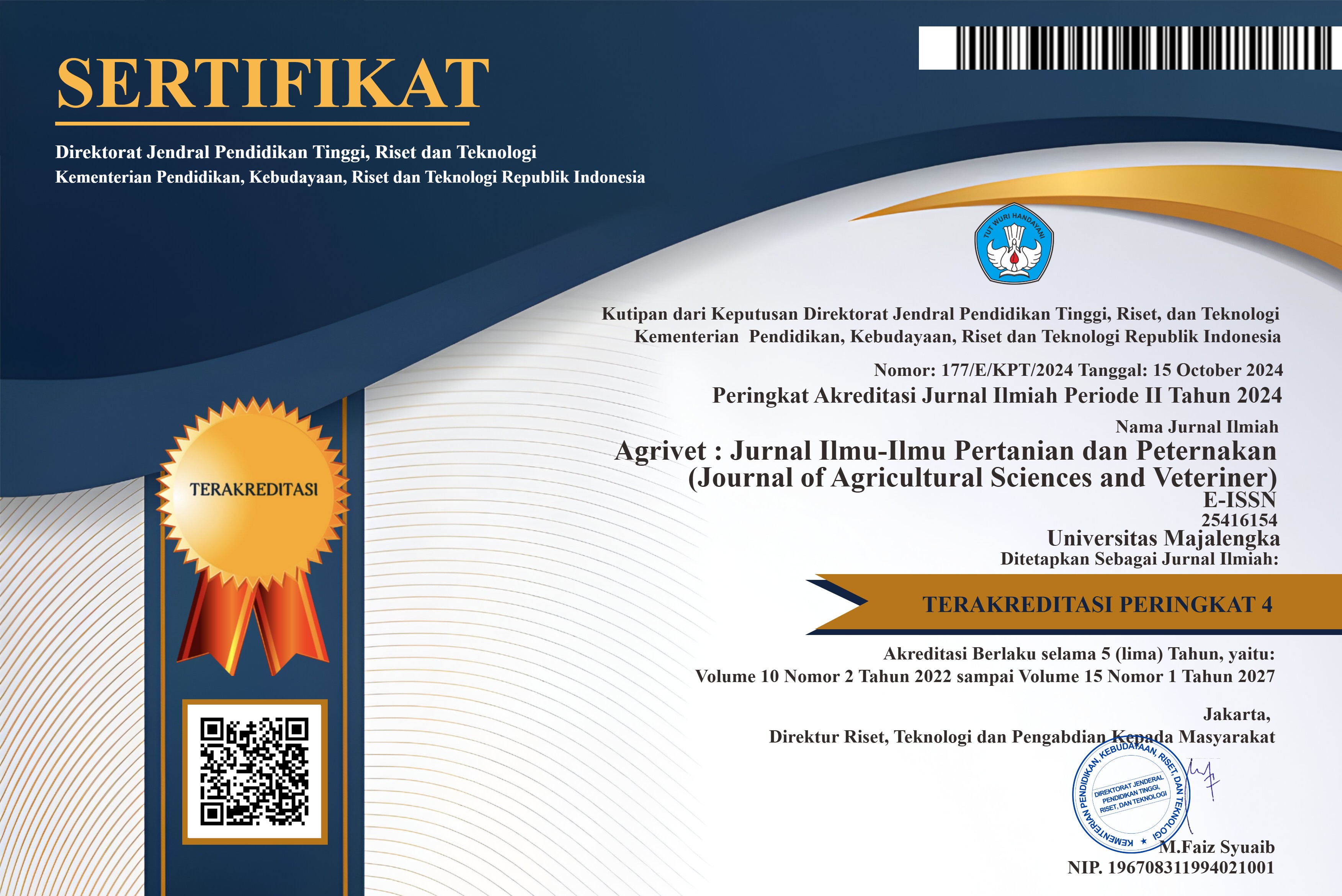Perbandingan jumlah total bakteri, kadar lemak, dan protein susu segar pada penyimpanan suhu rendah (4 – 6° C) dan suhu ruang
DOI:
https://doi.org/10.31949/agrivet.v11i2.7771Abstract
The method and duration of storage are crucial factors determining quality of fresh milk, as assessed by total bacterial, fat content, and protein content of fresh milk. This research aims to determine the comparison of the total bacterial count, fat content, and protein content of fresh milk stored at a low temperature and at room temperature. The research subjects used were fresh milk obtained from a single cow in a single milking process, stored at a low temperature of 4 – 6 ℃ and at room temperature, and then tested and compared for the total bacterial count, fat content, and protein content after storage for the 2nd, 4th, and 6th hours. The data obtained was statistically analyzed using the student’s t-test at a confidence level of α = 95%. The result showed that there a significant difference (p<0,05) in total bacterial and fat content. Within 6 hours, at a low temperature, total bacterial increased from the initial 3,07 × 105 cfu/ml to 5,95 × 105 cfu/ml, while at room temperature, it rose to 21.02 × 105 cfu/ml. The initial fat content was 4,14%, and after 6 hours of storage, at a low temperature, fat content decreased to 3,35%, whereas at room temperature, it dropped below the SNI standard of 3 to 2,91%. As for the protein content of the milk, both at low and room temperatures, the protein did not decrease and did not show a significant difference (p<0,05). It can be concluded that up to two hours of storage, the quality of milk is not affected by temperature. However, after being stored for more than two hours, the storage temperature does impact the total bacterial count and the fat content of the milk.
Keywords:
raw milk, low temperature storage, total bacteria, fat content, protein contentDownloads
References
Abrar, M. (2013). Pengembangan Model untuk Memprediksi Pengaruh Bakteri pada Susu Segar. Jurnal Medika Veterinaria, 7(2), 109–112.
Anindita. N. dan Soyi. D. S. (2017). Studi kasus: Pengawasan Kualitas Pangan Hewani melalui Pengujian Kualitas Susu Sapi yang Beredar di Kota Yogyakarta. Jurnal Peternakan Indonesia. 19.(2).
Asiah, N., Cempaka, L., Ramadhan, K., dan Matatula, S. H. (2020). Prinsip Dasar Penyimpanan Pangan pada Suhu Rendah. Nasmedia.
Badan Pusat Statistik. (2021). Produksi Susu Segar Menurut Provinsi (Ton), 2019-2021. [https://www.bps.go.id/indicator/24/493/1/produksi-susu-segar-menurut-provinsi.html]. Accesed date: 19 November 2022.
Badan Standarisasi Nasional. (2011). SNI Susu Segar (SNI 3141.1:2011). Badan Standarisasi Nasional. Jakarta.
Fachreza, M., Roza, E., Mujirudin, M. (2016). Pemantauan Suhu Pendingin Ruangan Menggunakan Mikrokontroller. Jurnal Uhamka. Jakarta.
Ghozali, Imam. (2009) Aplikasi Analisis Multivariate Dengan Program SPSS Edisi Keemapat. Penerbit Universitas Diponegoro. Semarang.
Hickey, C. D., Sheehan, J. J., Wilkinson, M. G., dan Auty, M. A. E. (2015). Growth and Location of Bacterial Colonies Within Dairy Foods Using Microscopy Techniques: A review. Dalam Frontiers in Microbiology. Frontiers Research Foundation.
Larry, M., dan James, T. P. (2001). BAM Chapter 3: Aerobic Plate Count. U. S. Food and Drug Administration. [https://www.fda.gov/food/laboratory-methods-food/bam-chapter-3-aerobic-plate-count] Accesed date: 19 November 2022.
Li. (2012). Quorum Sensing and Bacterial Social Interactions in Biofilms. MDPI. 12, 2519–2538.
Mankai, M., Boulares, M., Ben Moussa, O., Karoui, R., dan Hassouna, M. (2012). The Effect of Refrigerated Storage of Raw Milk on The Physicochemical and Microbiological Quality of Tunisian Semihard Gouda-Type Cheese During Ripening. International Journal of Dairy Technology, 65(2), 250–259.
Rachmawan, O. (2001). Penanganan Susu Segar. Departemen Pendidikan Nasional.
Sumarlin, L. O., Mulyadi, D., Suryatna, dan Asmara, Y. (2013). Identifikasi Potensi Enzim Lipase dan Selulase pada Sampah Kulit Buah Hasil Fermentasi. Jurnal Ilmu Pertanian Indonesia. 18 (3).
Treichel, H., de Oliveira, D., Mazutti, M. A., Di Luccio, M., dan Oliveira, J. V. (2010). A Review on Microbial Lipases Production. Journal Food and Bioprocess Technology. 3(2).
Zacharov, E. H., dan Halpern, M. (2007). Culturable Psychrotrophic Bacterial Communities in Raw Milk and Their Proteolytic and Lipolytic Traits. Journal Applied and Environmental Microbiology. 73(22).
Published
How to Cite
Issue
Section
License
Copyright (c) 2023 Fajar Firdaus Afandi, Raden Febrianto Christi, Wendry Setiyadi Putranto

This work is licensed under a Creative Commons Attribution-ShareAlike 4.0 International License.
An author who publishes in the Jurnal Agrivet agrees to the following terms:
- Author retains the copyright and grants the journal the right of first publication of the work simultaneously licensed under the Creative Commons Attribution-ShareAlike 4.0 License that allows others to share the work with an acknowledgment of the work's authorship and initial publication in this journal
- The author is able to enter into separate, additional contractual arrangements for the non-exclusive distribution of the journal's published version of the work (e.g., post it to an institutional repository or publish it in a book) with the acknowledgment of its initial publication in this journal.
- The author is permitted and encouraged to post his/her work online (e.g., in institutional repositories or on their website) prior to and during the submission process, as it can lead to productive exchanges, as well as earlier and greater citation of the published work












